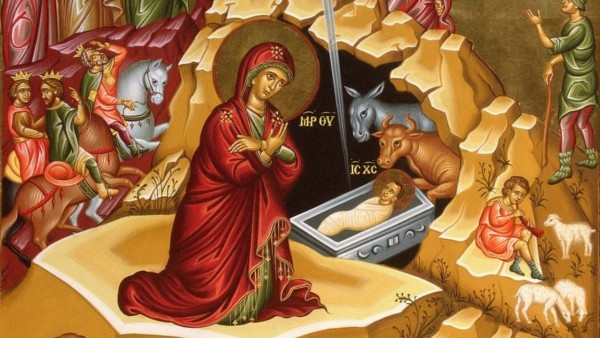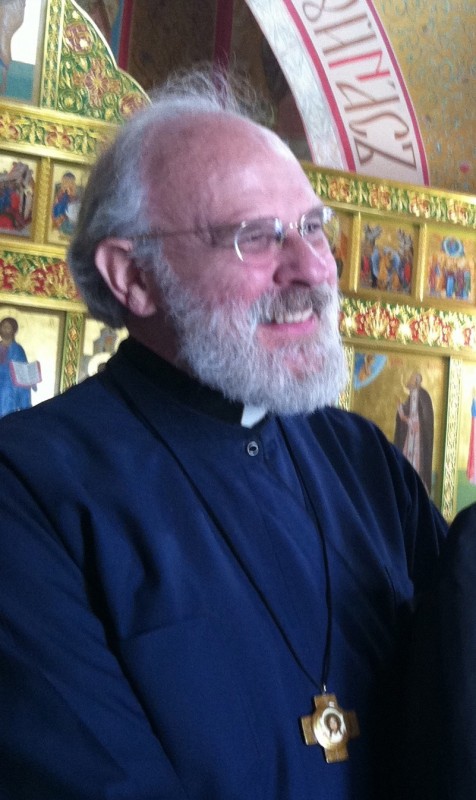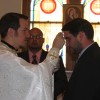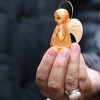Fr. Brendan Pelphrey is a priest of the Greek Orthodox Archdiocese of America, serves as presiding priest at St Sophia Greek Orthodox Church in San Antonio, Texas.
During this time of year there are always remarkable claims about Christmas which make the rounds of the internet, radio shows and gossip at the office. Some of these can be disturbing, especially to our children. An example currently circulating on the internet is the claim that Christmas is a pagan holiday originally celebrated by Romans, and which has nothing to do with Jesus Christ. Another says that Jesus never existed, but was actually a mythological figure in the Zoroastrian religion. Still another says that if you have a Christmas tree, you are a pagan because the Christmas tree was sacred to the Druids.
Apart from these claims, we may be familiar with protests by Jehovah’s Witnesses–and members of certain other grumpy sects–that since Christmas is not mentioned in the Bible it should not be celebrated by Christians.On the other extreme are friends who argue that the Virgin Mary was not a virgin, offering as evidence that the prophecy in Isaiah 7:14 merely reads, “a young woman shall conceive and bear a son, and shall call his name Immanuel.”
How can we respond to all these claims, and many others like them? Never mind the Grinch–has Christmas been stolen by the real facts of history?
To respond to these things, Orthodox should, first of all, make themselves familiar with the actual biblical accounts of Jesus’ birth.These are found in the Gospels of Matthew, ch. 1-2, and Luke, ch. 1-2. We should also be familiar with prophecies regarding the Messiah found in the Old Testament prophets–for example, Isaiah 7:14, 9:6-7, and 60:1-2 (frequently quoted at Christmastime).
Here are some Amazing Facts which can help you or your friends counter claims which you may hear while shopping or at work, or which your children may encounter at school.The following topics are actually taken from questions raised by children and adult members of our cathedral, and from the internet.
Jesus never existed. He was actually a Persian god (or Zoroastrian god) named Mithras, who was said to be born on December 25.
Answer: Ancient Persians, along with the Aryans of ancient India, worshipped the god Mithras who was said to be the “covenant-maker.” Mithras was associated with placing the stars and planets in their constellations and orbits. Mithras was said to have been born on December 25, emerging from under a rock (some say, from a cave). He was associated with December 25 because this is the Winter Solstice.
By Christian times Mithras was no longer important in Persia. Romans celebrated December 25 as the festival of sol invictus (“the invincible sun”). Meantime, however, a new Mithras-cult had arisen in the Roman Empire, for entirely different reasons. In around 128 BC a Greek astronomer, Hipparchus, discovered that the sun was rising in a new position each year. Over a period of time–about 2,160 years–the sun rises in a new constellation when measured during the equinox (a phenomenon known today as “solar precession”). Around 4,000 BC the sun had moved into Taurus; around 2,000 it had moved into Aries. Soon it would move into Icthys (Pisces).
This startling discovery gave rise to a new secret religion which astronomers called “Mithraism” in honor of the ancient god from Persia. Mithraism became very popular among Romans during the decades immediately before and after the rise of Christianity. It was a secret society limited to men, meeting in Mithra-temples carved into caves or underground. In Mithra-temples the god Mithras–identified by a Persian red hat–is depicted seated on a bull (symbolizing the constellation Taurus), slaying him with a knife. Depicted around him are Aries, Icthys, and finally Aquarius (which, Hipparchus correctly predicted, would be the next constellation–occuring in our own time!).
When the Emperor Constantine the Great legitimized Christianity in the fourth century, he instituted the Christian festival of Theophany (“the appearance of God”), replacing sol invictus with the Christian celebration. Later the celebration of Epiphany was instituted on January 7. Constantine was wise to replace the Roman worship of the sun with worship of Jesus Christ. This strategy also helped to do away with the secret worship of Mithras.
Did his strategy work? Well, who do you know who worships Mithras–or the sun, for that matter–on December 25? (Ok, there are some Neo-pagans who do–but that is another story.) By the way, Jesus really was born in a cave, which Judean shepherds used for barns, as they still do today.
Jesus wasn’t born on December 25. He wasn’t born on January 7 either.
Of course not. The Gospels tell us that Jesus was born in the spring-time, or perhaps early fall (during lambing season, when “the shepherds were keeping watch over their flocks in the fields by night”). As already pointed out above, Christians didn’t celebrate the day of Jesus’ birth, but the Incarnation of the Son of God. By the way, Jews didn’t celebrate birthdays, which is probably why the Gospels don’t tell us the date of Jesus’ birth. January 6, the Feast of Epiphany, was connected with Jesus’ baptism or the public proclamation of His ministry. However, it is interesting that since the adoption of the Gregorian Calendar by the western nations and most of the Church, the actual day of December 25 in the Julian Calendar (the “old calendar”) falls on the “new-calendar” day of January 7. Therefore, certain Orthodox Christians (“old-calendarists” in Russia, Ukraine, and Greece) celebrate Jesus’ birthday on the western date of January 7.
The Three Kings didn’t really come to worship Jesus. Actually, Persian (Parthian) astrologers sent a delegation to the Emperor Nero in around 66 AD and offered him gifts.
First of all, the Three Kings from the Orient were not three, they weren’t kings, they weren’t from the Orient, and…they weren’t there at Jesus’ birth. The Gospel tells us that they were magi, i.e. “sorcerers.” This term was used to indicate Zoroastrian astrologers. Christian tradition cites more than three astrologers–perhaps as many as nine–coming from different places, including north Africa (they were not, though, from the “Orient”) and converging on Jerusalem. There, they inquired about the auspicious birth of a new king. Jews would of course have interpreted this inquiry in terms of prophecies about a coming Messiah (Anointed One). As a result the Magi were pointed to Bethlehem, as foretold in Micah 5:2. Herod’s reaction indicates that the Magi arrived perhaps two years after Jesus’ birth. Matthew’s Gospel tells us that they went “into the house,” which means that Jesus’ family was no longer at the cave where he was born. There is an account of a Parthian delegation to Nero in about the year 66.This is not surprising; Nero demanded the personal adulation of people of all nations, thinking of himself as a god.
Evergreen trees were worshipped by Druids. This proves that Christmas was originally a pagan holiday. If you have a Christmas tree, you are a pagan, too!
Ancient Celts of Europe and Britain did connect the Winter Solstice with certain evergreen trees and plants, including the mistletoe, holly, firs, and the oak (a tree particularly sacred to the Celts). Christian missionaries to the Celts sometimes chopped down sacred trees. When they did this, local people expected the gods to destroy the missionaries. When nothing happened the Celts converted. Traditionally, however, it was Martin Luther, the founder of the Protestant Reformation in Germany in the sixteenth century, who brought the evergreen tree into the house and decorated it with a star (recalling the star of Bethlehem) and candles (indicating that Christ is the “light of the world”). St. Francis of Assisi, in the eleventh century, originated the custom of setting up a Nativity Scene or crecheto recall Jesus’ humble birth. Having a tree doesn’t make you a pagan. However, be careful not to eat the berries from mistletoe–they are poisonous, which is why the Celts treated them with superstition!
Mary wasn’t really a virgin. The prophecy in Isaiah simply says “a young woman.”
But Greek Christians thought she was a virgin because the Greek translation of the Old Testament passage uses the word parthene, misleading the Greeks.
Actually, the Hebrew text for Isaiah 7:14 uses the word almah which really does mean “virgin.” Yes, it can mean “unmarried woman,” though it would have been assumed that unmarried women were virgins. The same word also connotes “concealment,”i.e. not exposed to sexual relations. (If you doubt that the word means “virgin,” find a Hebrew-speaking Jewish man with a young daughter and tell him that his daugher isn’t almah. Then duck, because he’s going to swing at you.) The Septuagint, a translation of the Hebrew Old Testament into Greek in the third century BC, uses the appropriate Greek translation, parthene. Note that the Septuagint translation was made by Jews, not Greeks. Also note that the passage in Isaiah is about seeking a miraculous sign. If the passage had only meant that a “young woman will become pregnant,” that’s no miracle. Neither Jews nor Christians understood the prophecy in that way.

















